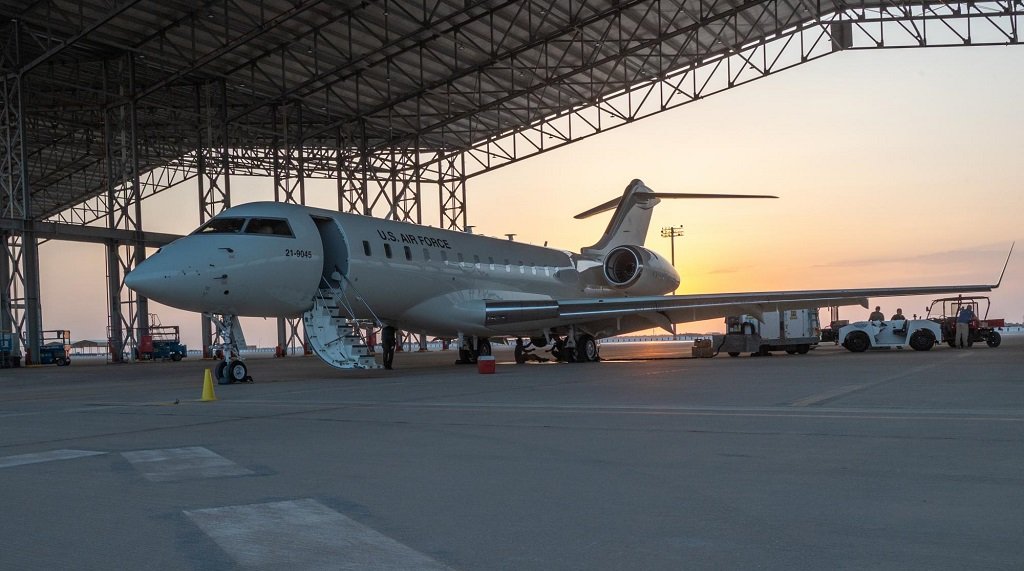[ad_1]

A new U.S. Air Force E-11A BACN aircraft sits parked at Prince Sultan Air Base, Kingdom of Saudi Arabia, Dec. 16, 2022. This E-11A is the newest addition to 430th Expeditionary Electronic Communications Squadron’s fleet. (U.S. Air Force photo by Staff Sgt. Shannon Bowman)
This new aircraft will relieve the pressure on the fleet after a E-11 crashed in 2020 and will allow to sustain a high mission capable rate.
The U.S. Air Force 430th Expeditionary Electronic Communications Squadron “Black Wolves” received a new E-11A aircraft with the Battlefield Airborne Communication Node payload, which arrived at Prince Sultan Air Base, Saudi Arabia, on December 16, 2022. The 430th EECS is the only unit that operates the E-11A and provides consistent and effective communication channels for air, ground and maritime forces in the U.S. Central Command area of responsibility.
The aircraft is the first delivered under a contract signed in 2021 to procure up to six new E-11As over the following five years. This intention was announced a year after the fatal crash in Afghanistan of one of the E-11As already in service, which reduced the fleet from four aircraft to three. The first three new aircraft were confirmed in 2021, while in 2022 two other aircraft were ordered, bringing the total to five. The last aircraft is expected to be ordered this year.
“This new E-11A will relieve the pressure on the rest of our fleet and enable us to sustain a high mission capable rate,” said Lt. Col. Todd Arthur, the 430th EECS commander. “Having an additional aircraft will give our maintenance team another option to reliably put combat airpower into the skies.”
The E-11A is based on the Bombardier BD-700-1A10 business jet, also known as Global 6000, which requires no external modifications as the BACN payload is carried internally. The aircraft, first leased at the beginning of the program and later bought by the Air Force in 2011, transitioned in 2019 from contingency funding to a long-term program of record. All the E-11As were assigned to the 430th EECS at Kandahar Airfield, Afghanistan, from where they provided near constant coverage in theater together with the EQ-4B.

Following the withdrawal from Afghanistan, the unit moved to Prince Sultan Air Base, Saudi Arabia, from where they are continuing their mission. Since the BACN mission’s inception in 2008, the 430th has delivered more than 200,000 flight hours and proven to be an essential component to modern war fighting.
With the high mission success rates the E-11A has demonstrated in the Middle East, and the strategic capability advantages the aircraft brings to the joint force, the Air Force has announced plans to bring a new E-11A BACN squadron to Robins Air Force Base, Georgia. “The Air Force and U.S. Congress have recognized what the E-11A platform brings to the fight,” Lt.Col. Arthur said. “As a result, we are standing up a new squadron of E-11s at Robins AFB in February of 2023.”
This first new E-11A, serial number 21-9045, was transferred to the Air Force by Bombardier in September, before being moved few days later to Hansom Air Force Base, Massachusetts, headquarter of the BACN Program Office. The aircraft is newly built, since it only left the factory in early 2021, as opposed to the current E-11s which are about 15 years old.
The BACN payload, defined as a “Wi-Fi in the sky”, was developed also as the first step towards multi-domain operations, acting as a “gateway” system that allows aircraft with incompatible radio systems and datalinks to transfer information and communicate. BACN is reportedly being modified to allow fourth- to fifth-generation data sharing between fighter jets, with upgraded navigation and GPS systems and Link-16.
[ad_2]
Source link
